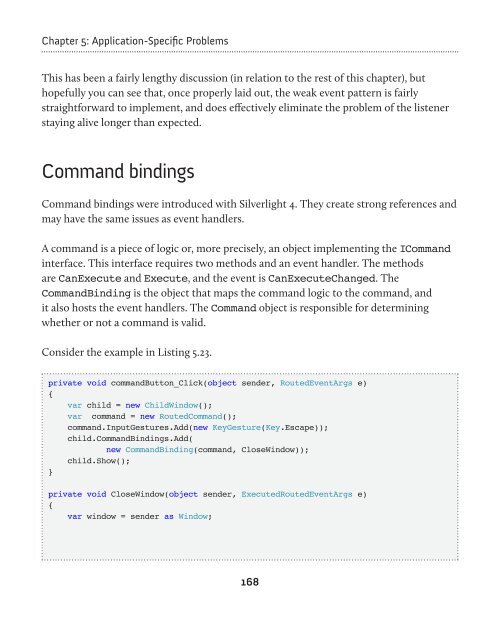Under the Hood of .NET Memory Management - Simple Talk
Under the Hood of .NET Memory Management - Simple Talk
Under the Hood of .NET Memory Management - Simple Talk
Create successful ePaper yourself
Turn your PDF publications into a flip-book with our unique Google optimized e-Paper software.
Chapter 5: Application-Specific Problems<br />
This has been a fairly lengthy discussion (in relation to <strong>the</strong> rest <strong>of</strong> this chapter), but<br />
hopefully you can see that, once properly laid out, <strong>the</strong> weak event pattern is fairly<br />
straightforward to implement, and does effectively eliminate <strong>the</strong> problem <strong>of</strong> <strong>the</strong> listener<br />
staying alive longer than expected.<br />
Command bindings<br />
Command bindings were introduced with Silverlight 4. They create strong references and<br />
may have <strong>the</strong> same issues as event handlers.<br />
A command is a piece <strong>of</strong> logic or, more precisely, an object implementing <strong>the</strong> ICommand<br />
interface. This interface requires two methods and an event handler. The methods<br />
are CanExecute and Execute, and <strong>the</strong> event is CanExecuteChanged. The<br />
CommandBinding is <strong>the</strong> object that maps <strong>the</strong> command logic to <strong>the</strong> command, and<br />
it also hosts <strong>the</strong> event handlers. The Command object is responsible for determining<br />
whe<strong>the</strong>r or not a command is valid.<br />
Consider <strong>the</strong> example in Listing 5.23.<br />
private void commandButton_Click(object sender, RoutedEventArgs e)<br />
{<br />
var child = new ChildWindow();<br />
var command = new RoutedCommand();<br />
command.InputGestures.Add(new KeyGesture(Key.Escape));<br />
child.CommandBindings.Add(<br />
new CommandBinding(command, CloseWindow));<br />
child.Show();<br />
}<br />
private void CloseWindow(object sender, ExecutedRoutedEventArgs e)<br />
{<br />
var window = sender as Window;<br />
168











